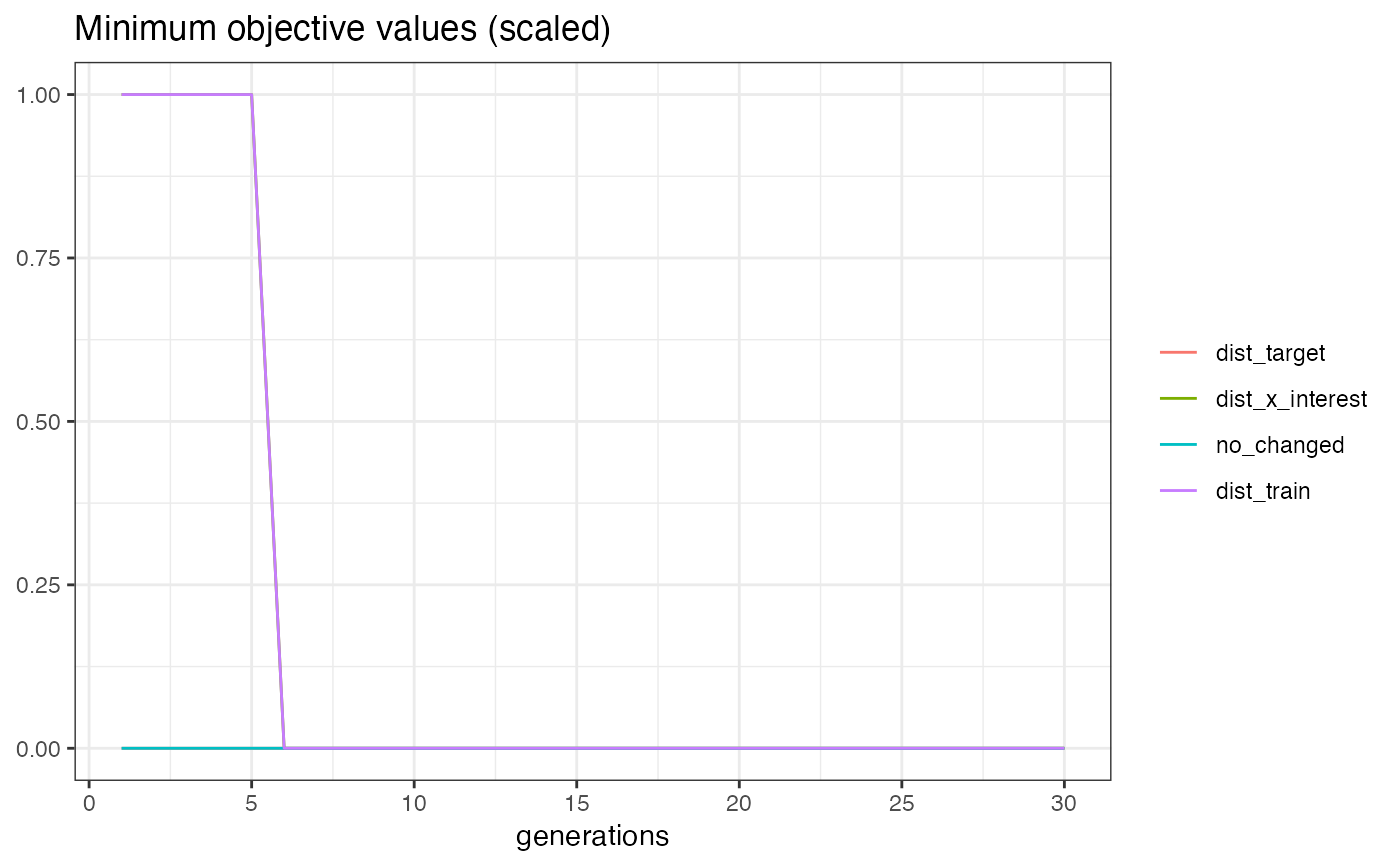RandomSearch randomly samples a population of candidates and returns non-dominated candidates w.r.t to the objectives
of MOC (Dandl et. al 2020) as counterfactuals. RandomSearch is equivalent to MOC with zero generations and the random
initialization strategy.
The four objectives of MOC (Dandl et. al 2020) to are:
Distance to
desired_prob(classification tasks) ordesired_prob(regression tasks).Dissimilarity to
x_interestmeasured by Gower's dissimilarity measure (Gower 1971).Number of feature changes.
(Weighted) sum of dissimilarities to the
knearest data points inpredictor$data$X.
Details
RandomSearch is typically used as a baseline in benchmark comparisons with MOC.
The total number of samples drawn is mu * n_generations. Using separate parameters mu and n_generations
is only required to make certain statistics comparable with MOC (e.g. the evolution of the dominated hypervolume).
References
Dandl, S., Molnar, C., Binder, M., and Bischl, B. (2020). "Multi-Objective Counterfactual Explanations". In: Parallel Problem Solving from Nature – PPSN XVI, edited by Thomas Bäck, Mike Preuss, André Deutz, Hao Wang, Carola Doerr, Michael Emmerich, and Heike Trautmann, 448–469, Cham, Springer International Publishing, doi:10.1007/978-3-030-58112-1_31 .
Deb, K., Pratap, A., Agarwal, S., & Meyarivan, T. A. M. T. (2002). "A fast and elitist multiobjective genetic algorithm: NSGA-II". IEEE transactions on evolutionary computation, 6(2), 182-197.
Goldstein, A., Kapelner, A., Bleich, J., and Pitkin, E. (2015). "Peeking Inside the Black Box: Visualizing Statistical Learning with Plots of Individual Conditional Expectation". Journal of Computational and Graphical Statistics 24 (1): 44–65. doi:10.1080/10618600.2014.907095 .
Gower, J. C. (1971). A general coefficient of similarity and some of its properties. Biometrics, 27, 623–637.
Li, Rui, L., Emmerich, M. T. M., Eggermont, J. Bäck, T., Schütz, M., Dijkstra, J., Reiber, J. H. C. (2013). "Mixed Integer Evolution Strategies for Parameter Optimization." Evolutionary Computation 21 (1): 29–64. doi:10.1162/EVCO_a_00059 .
Super classes
counterfactuals::CounterfactualMethod -> counterfactuals::CounterfactualMethodRegr -> RandomSearchRegr
Active bindings
optimizer(OptimInstanceBatchMultiCrit)
The object used for optimization.
Methods
Method new()
Create a new RandomSearchRegr object.
Usage
RandomSearchRegr$new(
predictor,
fixed_features = NULL,
max_changed = NULL,
mu = 20L,
n_generations = 175L,
p_use_orig = 0.5,
k = 1L,
weights = NULL,
lower = NULL,
upper = NULL,
distance_function = "gower"
)Arguments
predictor(Predictor)
The object (created withiml::Predictor$new()) holding the machine learning model and the data.fixed_features(
character()|NULL)
Names of features that are not allowed to be changed.NULL(default) allows all features to be changed.max_changed(
integerish(1)|NULL)
Maximum number of feature changes.NULL(default) allows any number of changes.mu(
integerish(1))
The population size. Default is20L. The total number of random samples is set tomu * n_generations. See theDetailssection for further details.n_generations(
integerish(1))
The number of generations. Default is175L. The total number of random samples is set tomu * n_generations. See theDetailssection for further details.p_use_orig(
numeric(1))
Probability with which a feature/gene is reset to its original value inx_interestafter random sampling. Default is0.5.k(
integerish(1))
The number of data points to use for the forth objective. Default is1L.weights(
numeric(1) | numeric(k)|NULL)
The weights used to compute the weighted sum of dissimilarities for the forth objective. It is either a single value or a vector of lengthk. If it has lengthk, the i-th element specifies the weight of the i-th closest data point. The values should sum up to1.NULL(default) means all data points are weighted equally.lower(
numeric()|NULL)
Vector of minimum values for numeric features. IfNULL(default), the element for each numeric feature inloweris taken as its minimum value inpredictor$data$X. If notNULL, it should be named with the corresponding feature names.upper(
numeric()|NULL)
Vector of maximum values for numeric features. IfNULL(default), the element for each numeric feature inupperis taken as its maximum value inpredictor$data$X. If notNULL, it should be named with the corresponding feature names.distance_function(
function()|'gower'|'gower_c')
The distance function to be used in the second and fourth objective. Either the name of an already implemented distance function ('gower' or 'gower_c') or a function. If set to 'gower' (default), then Gower's distance (Gower 1971) is used; if set to 'gower_c', a C-based more efficient version of Gower's distance is used. A function must have three argumentsx,y, anddataand should return adoublematrix withnrow(x)rows and maximumnrow(y)columns.
Method plot_statistics()
Plots the evolution of the mean and minimum objective values together with the dominated hypervolume over
the generations. All values for a generation are computed based on all non-dominated individuals that emerged until
that generation. The randomly drawn samples are therefore split into n_generations folds of size mu.
This function mimics MOCs plot_statistics() method. See the Details section for further information.
Method get_dominated_hv()
Calculates the dominated hypervolume of each generation. The randomly drawn samples are therefore split
into n_generations folds of size mu.
This function mimics MOCs get_dominated_hv() method. See the Details section for further information.
Method plot_search()
Visualizes two selected objective values of all emerged individuals in a scatter plot.
The randomly drawn samples are therefore split into n_generations folds of size mu.
This function mimics MOCs plot_search() method. See the Details section for further information.
Usage
RandomSearchRegr$plot_search(objectives = c("dist_target", "dist_x_interest"))Examples
if (require("randomForest")) {
# Train a model
rf = randomForest(mpg ~ ., data = mtcars)
# Create a predictor object
predictor = iml::Predictor$new(rf)
# Find counterfactuals for x_interest
rs_regr = RandomSearchRegr$new(predictor, n_generations = 30L)
cfactuals = rs_regr$find_counterfactuals(x_interest = mtcars[1L, ], desired_outcome = c(22, 26))
# Print the counterfactuals
cfactuals$data
# Plot evolution of hypervolume and mean and minimum objective values
rs_regr$plot_statistics()
}
#> [[1]]
 #>
#> [[2]]
#>
#> [[2]]
 #>
#> [[3]]
#>
#> [[3]]
 #>
#>